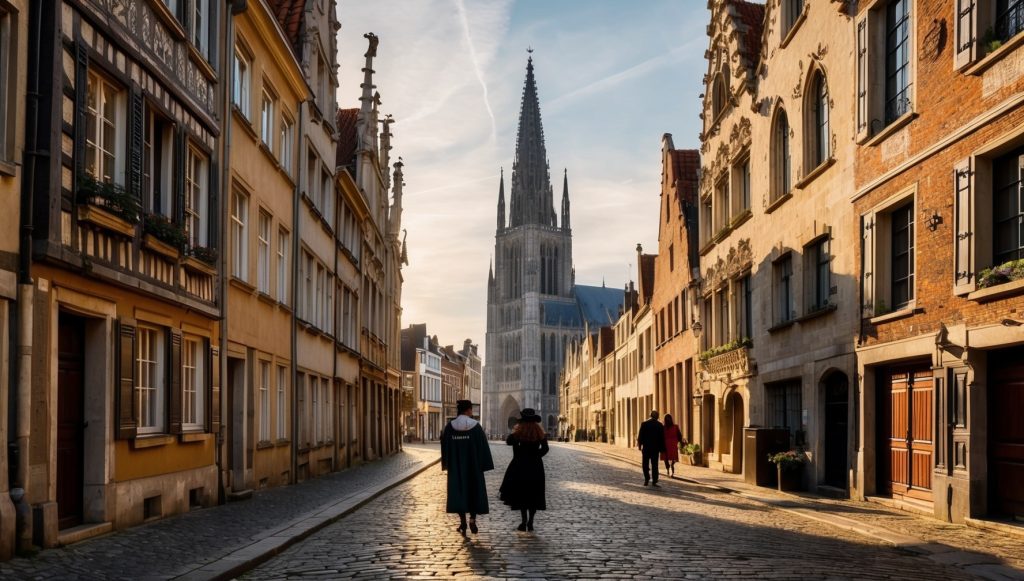Antwerp, a city steeped in history, offers a unique glimpse into the past through its well-preserved medieval streets. Wandering these ancient pathways, you can almost hear the echoes of centuries-old footsteps, feel the vibrancy of medieval trade, and sense the enduring spirit of the city’s rich cultural heritage. Antwerp’s medieval streets are more than just cobblestones and old buildings; they are a living connection to a time when the city was a bustling hub of commerce, art, and innovation.
The Heart of Medieval Antwerp
Grote Markt: The Historical Center
At the heart of Antwerp lies the Grote Markt, the city’s historical center. This grand square is surrounded by ornate guildhalls, each reflecting the wealth and power of the medieval trade guilds that once dominated the city. The towering Antwerp Cathedral of Our Lady, with its intricate Gothic architecture, stands as a centerpiece, symbolizing Antwerp’s religious and cultural significance. The Grote Markt remains a vibrant place where history and modern life intersect, with cafes, shops, and events bringing the past into the present.
The Hidden Alleyways
Venturing off the beaten path, you’ll discover the hidden alleyways of Antwerp, where the medieval character of the city truly comes alive. These narrow, winding streets, often overlooked by tourists, offer a more intimate experience of the city’s history. Places like Vlaeykensgang, a charming alleyway dating back to 1591, transport visitors to a bygone era with their preserved facades and quiet courtyards. Walking through these alleys is like stepping back in time, providing a sense of what life was like in medieval Antwerp.
Architectural Marvels
The Stone Houses of Zirkstraat
Zirkstraat is another gem among Antwerp’s medieval streets, known for its collection of stone houses that date back to the 16th century. These buildings, with their distinctive stepped gables and sturdy stone construction, reflect the architectural style of the period. Walking along Zirkstraat, you can appreciate the craftsmanship that went into building these homes, which have stood the test of time and continue to be a vital part of the city’s heritage.
The Butcher’s Hall (Vleeshuis)
One of the most iconic medieval buildings in Antwerp is the Butcher’s Hall, or Vleeshuis. Built in the early 16th century, this imposing structure served as a central market for meat traders and butchers, a crucial industry in medieval Antwerp. Today, the Vleeshuis is a museum dedicated to the history of music and dance in the city, but its Gothic architecture and historical significance make it a must-see for anyone exploring Antwerp’s medieval past.
The Cultural Tapestry
Trade and Commerce
During the medieval period, Antwerp was one of Europe’s most important trading centers, with its streets bustling with merchants, artisans, and traders from across the continent. The city’s strategic location on the River Scheldt made it a key port for goods and ideas, contributing to its rapid growth and prosperity. Walking through the medieval streets today, you can still see the remnants of this vibrant trade, from the grand merchant houses to the storied taverns that once hosted travelers and traders.
Art and Religion
Antwerp’s medieval streets are also a testament to the city’s deep connection to art and religion. The numerous churches, such as St. James’ Church and St. Paul’s Church, with their stunning architecture and rich interiors, reflect the city’s religious devotion. Meanwhile, the art that adorned these spaces, including works by masters like Peter Paul Rubens, speaks to the city’s status as a center of artistic excellence during the Renaissance, which had its roots in the medieval period.
Preserving the Past
Modern Conservation Efforts
Antwerp’s medieval streets have been meticulously preserved, thanks to ongoing conservation efforts by the city and heritage organizations. These efforts ensure that the unique character of the medieval architecture and street layouts is maintained, allowing future generations to experience the city’s rich history firsthand. Walking through these streets today, you can appreciate the care taken to preserve their authenticity while accommodating the needs of a modern city.
A Living History
The medieval streets of Antwerp are not just relics of the past; they are a living history, integrated into the daily life of the city. Locals and visitors alike traverse these streets, whether they are shopping, dining, or simply taking a leisurely stroll. The fusion of old and new is evident everywhere, making Antwerp a city where history is not just remembered but lived.
Conclusion
A walk through the medieval streets of Antwerp is a journey through time, offering a glimpse into the city’s storied past. From the grand buildings of the Grote Markt to the hidden alleyways and historic homes, these streets tell the tale of a city that has played a vital role in European history. As you explore these ancient pathways, you not only connect with the past but also experience the vibrant life of a city that continues to honor its heritage while embracing the future.


